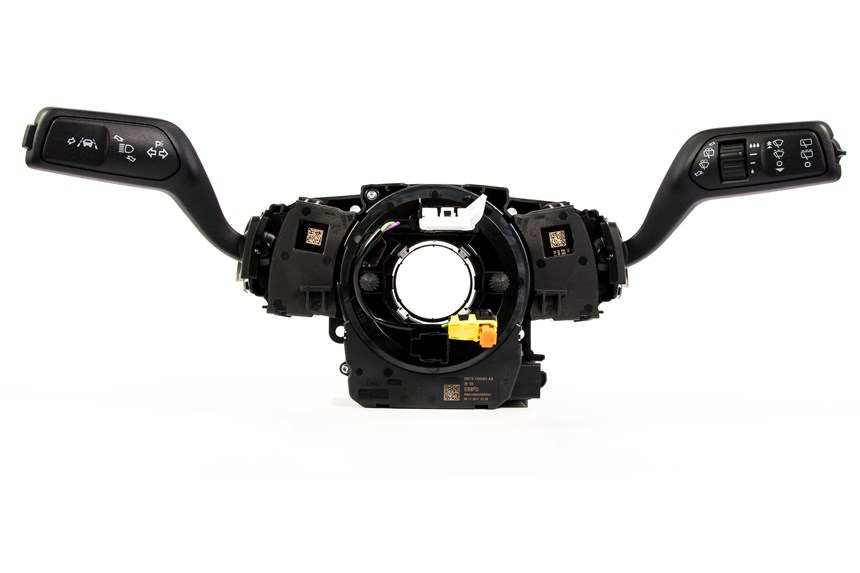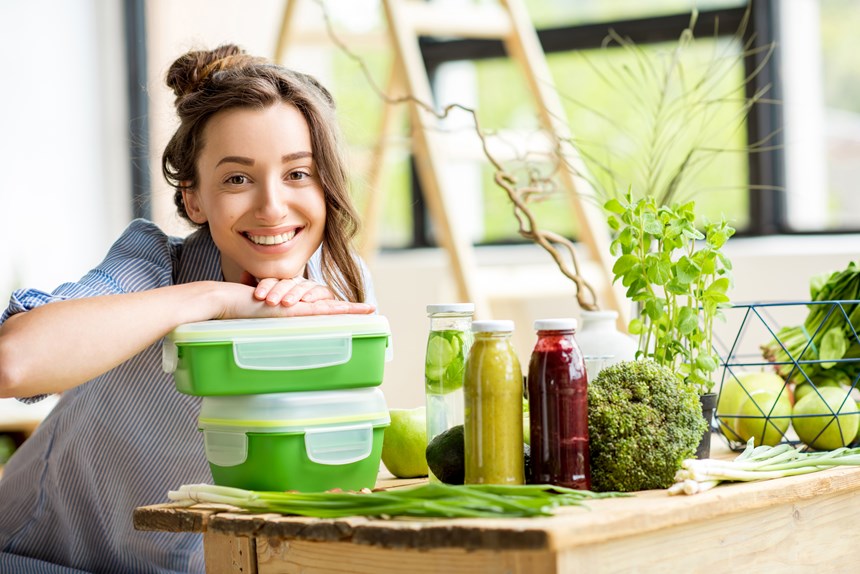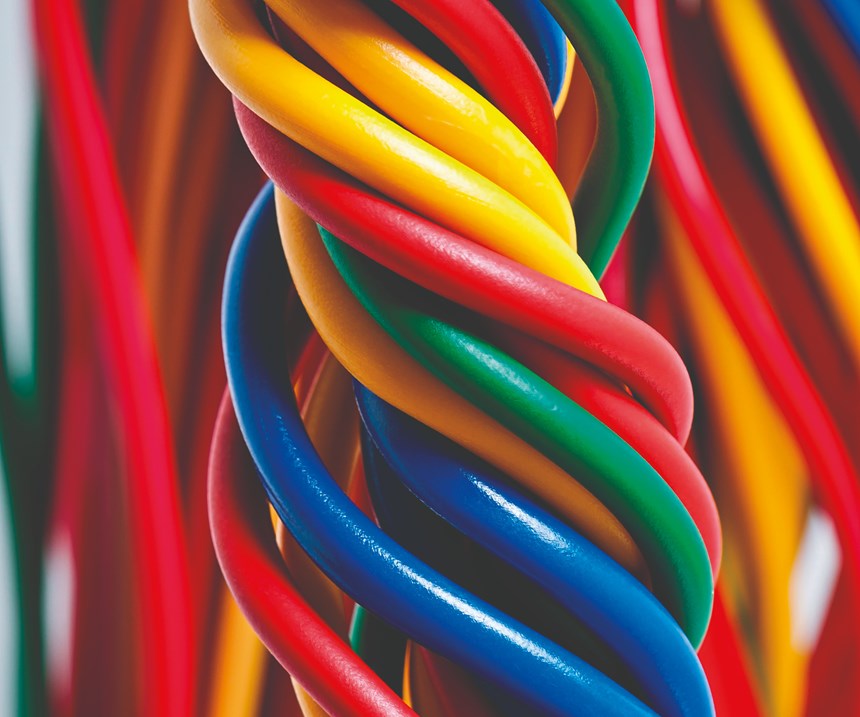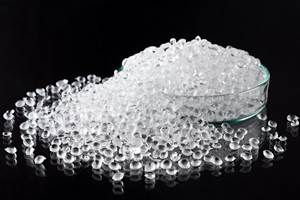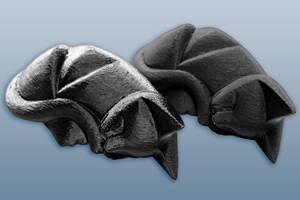The “Circular Economy” will be the dominant theme at the K 2019 show, Oct. 16-23, in Düsseldorf, Germany. Leading suppliers of materials and additives have all upped their focus on sustainability, evidenced by their adoption of a variety of new technologies—including new product formulations that lead to circular solutions (i.e., recycling) and reduce plastic waste. It underscores their commitment to the U.N.’s Sustainable Development Goals to address pressing issues—including energy and greenhouse gas reduction, solutions to environmental degradation, water conservation, and material efficiency.
Actions undertaken by materials suppliers include chemical recycling, advanced mechanical recycling, incorporation of biobased feedstocks, recycle-content resins with performance equivalent to their virgin counterparts, as well as plastic formulations that are easier to recycle and/or are lighter in weight yet offer optimal performance, ranging from packaging to automotive and electronic parts.
Consistent with the “circular” theme, additives suppliers are addressing sustainability with colorants and additives that are more environmentally friendly or have bio content, allow for easier recyclability, and reduce material waste.
Visitors can expect to see new engineered thermoplastics that meet key trends in automotive, including electrification of vehicles and automated driving, E&E, packaging, and healthcare.
Materials Suppliers Partner Up
Industry partnerships characterize several efforts being undertaken by materials suppliers. Recently reported industry collaborations include LyondellBasell and producer of renewable hydrocarbons Neste, which announced the first parallel production of bio-based PP and LDPE at a commercial scale; and Dow and BioLogiQ, which are evaluating potential synergies between the latter’s NuPlastiQ plant-based biopolymer and Dow’s PE resins.
SABIC will address using bio-renewable and recycled feedstocks and designing lightweight packaging to extend shelf life of food, as well as solutions for reuse and recycling of industrial packaging through innovative processes and partner collaborations
The company is reportedly first in the industry to scale up a chemical recycling process for transforming mixed plastic waste back to new polymers, enabling downstream customers to develop high quality, recyclable product designs.
New solutions from SABIC for lightweighting are Cohers S ethylene-octene plastomer for film to enhance heat sealing, clarity, toughness and elasticity; and PP-UMS (ultra-melt-strength) to trim weight through foaming in automotive, packaging and building/construction.
Borealis is now owner of two recycling companies: mtm, a German recycler of rigid packaging, produces PCR-PP & PE for injection molding (e.g., paint pails—100% rPP and caps for non-food use—25% rPP); and Ecoplast, Austrian recycler of flexible package for reuse in film (e.g., 100% PCR garbage liner). The company will showcase its Borcycle recycling process, jointly developed with recycling machinery maker Erema. It is said to optimizes each step in the recycling process to produce higher quality recycle than is typical.
Borealis is now owner of two recycling companies.
Through mtm, new and improved recycled products will be highlighted by Borealis, including Borcycle MF1981SY, 80+% rPP plus 10% talc and Borealis Queo metallocene low-density PE plastomer (octene copolymer) as an impact modifier. This the first of a range of rPP grades, which boast a good stiffness/toughness balance, and targeted for use in visible black parts, such as small appliances.
The company will also show significant improvements to existing recycled Purpolen polyolefin grades, also made by mtm, including: PP Y40, an rPP with improved flow—raised to 40 g/10 min for injection molding thin-wall parts with long flow paths for pails, thick-wall packaging and appliance parts. PE FF is a fine-filtered PE (0.950 density) boasts reduced gel level and quality comparable to virgin for general-purpose applications. And PE Y01 is 100% PCR with low MFR and low gels for extrusion of pipe or blowing large bottles.
Nova Chemicals will highlight six new virgin PE grades (LL and MD) capable of accepting 20% or more recycle and also said to be themselves “more friendly to recycling.”
Ineos Styrolution is exploring various avenues toward achieving circular styrenics solutions. This includes PS chemical-recycling technology and the launch of new recycle-content PS grades.
Ascend Performance Materials will discuss new customized recycle-content nylon 66 to meet increasing demand.
BASF will highlight its certified-compostable ecovio resins, which now comprise a portfolio for applications from mulch films to fruit and vegetable bags and organic waste bags, which can be used throughout the entire food cycle.
Other engineering thermoplastic suppliers, like Lanxess, Covestro and Solvay are all working toward establishing closed-loop material cycles in the manufacture and application of their materials. A number of pilot projects are underway with customers and other industry partners.
Additives Suppliers Going Green
Similar actions are taking place in additives. Milliken’s Plastics Additives group will highlight its partnership with Chicago-based PureCycle Technologies to advance closed-loop recycling of PP. Using technology developed and licensed by Procter & Gamble Co., PureCycle plans to open in Ohio by 2021 its first plant employing a patented recycling method that restores virgin-like quality to waste PP.
Clariant is expanding its EcoTain label, currently awarded to more than 200 products that show outstanding sustainability advantages, to include EcoTain Partnerships that will foster collaboration between at least three partners in the value chain to create concrete sustainability and business impacts and advance environmental protection and the circular economy. At K 2019, Clariant will issue an open invitation to companies to come together and collaborate on one particularly challenging aspect of recycling.
BASF will highlight UV stabilizers and pigments that have good performance in recycled plastics and/or sorting of recycled plastics.
Songwon will show how technological expertise enables the development of materials that can help customers tackle a wide variety of environmental issues, including stabilizers that make plastics more durable, allowing easier recyclability and reducing waste.
Materials Galore for Automotive
BASF will launch Ultramid Advanced T2000, the latest addition to its PPA portfolio. Based on nylon 6T/66, it is said to combine excellent mechanical and dielectric strengths at high temperatures, a combination particularly crucial for E&E connectors. This PPA reportedly shows improved impact strength on par with standard nylon 66 and lower water uptake than standard aliphatic nylons. Comprising about 10 grades, T2000 is also a versatile candidate for automotive metal replacement such as water-outlet valves, water pumps, fuel-system components, actuators, transmission sensors and clutch parts.
Covestro will present a new interior concept for the “future car,” which it says will be a multifunctional, mobile living and working space. Covestro will highlight “smart materials” for new interiors, including new Makrolon PC grades and blends said to enable a range of glass-like surfaces and functional colors, critical for integration of innovative displays, sensors, cameras and ambient lighting systems.
Covestro will also showcase Makrolon PC films for printed 3D, large-scale cover plates for integrated displays. The films also serve as carrier for printed electronics in touchscreens for cars, whose use will increase drastically, Covestro says, with increasing digitalization and networking, as well as the trend towards autonomous driving. Seamless integration of displays is also supported by the firm’s new generation of Makrolon AI PC materials.
PC resins and blends are also candidates for 5G technology. Covestro will show a series of technical and design 5G antenna prototypes for small cells in the frequency range of 3.5 GHz and 28 GHz. Covestro will also show new films
PC resins and blends are also likely to be materials of choice for 5G technology.
for 5G smartphones. A Makrofol SR PC/PMMA multilayer film (with acrylic as the outside layer) combined with a new manufacturing process results in cellphone back covers that look like glass but are not fragile. This crystal-clear, 3D-formable and 5G-compatible film meets requirements for transmission at high radio frequencies with wavelengths in the millimeter range and is engineered for optimal design freedom to create fashionable mobile phones with decoration technologies such as UV patterning and non-conductive vacuum metalization.
Lanxess’ High Performance Materials (HPM) business unit will be launching a range of materials for electric mobility. The use of the color orange to identify live, plastic-sheathed components is becoming well-established in electric vehicles, but it is a challenge to develop orange compounds that exhibit high color stability over the long term. New HPM nylon 6 and PBT compounds for high-voltage applications will be colored in the highly vivid RAL 2003 (Lanxess color code 200849) tone. Another color variant is almost ready to be introduced.
Among the first to feature this new orange color are the glass-reinforced, halogen-free flame-retardant nylon 6 compounds Durethan BKV20FN01, BKV30FN04 and BKV45FN04. The latter meets UL 94V-0 at thickness of 0.4 mm. Also new is the hydrolysis-stabilized, glass-reinforced PBT Pocan BF4232HR. Colored orange, it also achieves 94V-0 classification at 0.4 mm. Other new HPM products prevent electrical corrosion upon contact with live metal parts; and there are halogen-free, flame-retardant materials for battery cell holders and cover plates.
In terms of lightweight design, Lanxess is working primarily on thermoplastic composites based on its Tepex prepregs. At K, look for a seat shell and highly integrated front-end carrier, both said to exhibit excellent crash resistance.
Also new from Lanxess are nylon and PBT compounds for cost-effective blow-molding of components for air management in turbocharged combustion engines and/or liners for vehicles powered by hydrogen and natural gas.
Ascend Performance Materials will highlight several new Vydyne nylon 66 grades, including high-temperature nylons for automotive; the company’s first long-chain nylon 66 grades for extruded fuel and brake lines; and flame-retardant grades for electrical applications.
Borealis will feature new grades of Fibremod Carbon compounds for automotive, including CG210SY, 20% carbon fiber in PP with improcws surface and dimensional stability; and CD211SY, a high-flow “hybrid” of 10% carbon fiber, 10% talc in PP.
SABIC has been working with leading automotive OEMs toward development of “breakthrough” plastic and metal replacement solutions. At K 2019, SABIC will feature new concepts for vehicle electrification involving conductive PC and PP.
INEOS Styrolution will unveil an expanded line of StyLight styrenic copolymer composites for automotive, ranging from seat structures, door carriers, and front-end modules to body panels and exterior and interior parts with a carbon fiber look. Also new is a high-flow ABS for auto interior and exterior parts, electronic housings, and medical devices like inhalers.
SABIC will feature new product concepts for vehicle electrification such as conductive PC and PP solutions.
Polyplastics will showcase new Duracon polyacetals (POM) for automotive, including grades for injection molded fuel-system components. Also new is a high-flow/high-rigidity acetal with MFR around 14, suited to wide range of molding conditions. Yet another new grade is said to combine high strength with good creep and sliding properties.
New from Polyplastics for electric vehicles are Durafide PPS and Duranex PBT targeted for peripheral engine parts such as power-control units to deliver high insulating properties, reduce water absorption, and meet harsh operating conditions.
Kraiburg TPE will unveil new compounds with optimized odor and emission behavior for auto interiors and consumer products, and TPEs with enhanced UV resistance and adhesion to plastics like ASA and PMMA for auto exteriors. Also on tap at K will be custom-engineered thermoplastic hybrids (TEHs) that provide superior chemical and thermal resistance.
DSM, active in additive manufacturing (AM) for over 25 years, will outline opportunities for AM at automotive OEMs--from producing vehicles in low volumes to incorporating individual customer requirements and tastes, and also production of spare parts. The latter is an area with huge potential, as it could help reduce inventory, typically at least 7% of an automotive OEM’s liquid assets, and also result in cost-cutting and carbon-footprint reduction.
Materials for Packaging, Industrial & More
BASF has extended its Ultradur PBT portfolio with what is said to be the first PBT for extrusion, B6551 LNI; and the first for thermoforming, B6560 M2 FC TF. Up to now the melt strength of PBT was not sufficient to make it a preferred product for extrusion. By connecting and branching the polymer chains via tailor-made additives, BASF gained very high melt strength. This reportedly makes B6551 LNI well suited for pipes, profiles and mandrels. And B6560 M2 FC TF competes for extrusion of films and thermoforming of packaging or technical parts.
Kraiburg TPE will launch two custom-engineered compound series with significantly better migration control than common TPEs. They are particularly suited for closure systems, valves and seals for packaging with direct contact to foods that contain fat.
Wacker will be presenting its new Elastosil LR 5040 liquid silicone rubber (LSR) series. Even without post-cure, this LSR shows excellent mechanical properties and meets strict regulatory requirements for sensitive applications in the baby care, food and medical technology. Wacker will present a live injection molding demo with the new LR5040 on a KraussMaffei machine.
Solvay will show its new thermoplastic composites for aerospace, automotive, and oil and gas. Beyond lightweighting, these materials reportedly feature exceptional heat and shock resistance, strength, toughness and chemical inertness.
Also new from Solvay is reportedly an industry-first high-temperature PEEK. Also showcased will be unique applications of the company’s long-fiber thermoplastic (LFT) materials, such as the world’s first all-polymer recyclable e-bike.
Evonik Industries, which this year marked the 40th anniversary of its Vestamid nylon 12 elastomer (PEBA), will introduce a new member of the product line--a popular, trusted material, especially in the athletic equipment industry. It boasts transparency and gloss levels that give designers far more freedom than they have ever had with PEBA.
Novel Additives, Pigments, Colorants
Solvay is launching Alve-One foaming solutions, an innovative generation of high-performance and cost-effective chemical blowing agents based on “100% safe” ingredients for a range of resins, including PVC, EVA and polyolefins. These formulations reportedly have no negative impact on human respiratory health and are safe for workers to handle without compromising efficiency and performance in plastic foaming.
A next-generation Tinuvin NOR HALS light and heat stabilizer will be highlighted by BASF. The company will also unveil new pigments, including two new Lumina Royal effect pigments: Russet enables new vibrant, high-chroma red shades and provides greater formulation flexibility; and Amber, which promises strong sparkle for attractive bronze, orange, golden and red effect shades.
Also new from BASF, Microlen Piano Black is said to enable the deepest and most enduring black and outstanding dispersion for high-end plastic design. And there are new black and red pigments recommended for recycling and other demanding applications. Due to its high heat and chemical stability, Sicopal Red K 3050 FK reportedly stands up to the most demanding applications, including engineering plastics. Building on the Sicopal Black technology, this new addition boasts best-in-class near-infrared (NIR) reflective properties, and addresses the current industry need for recyclable black plastics that can pass through infrared sorting at materials recycling facilities.
Lanxess’ Inorganic Pigments business will present a black pigment that reflects the infrared portion of sunlight 20% more effectively than conventional black pigments. Plastic roofs and facades offer a wealth of potential for use in reducing temperatures inside buildings.
With a partner that makes NIR scanners , Clariant developed new black colorants that can be identified by NIR sorting devices. These blacks can be used for various polymers and applications such as packaging and E&E.
Also notable from Clariant are pigments designed for coloring biodegradable plastics, and new halogen-free flame retardants that retain performance after the material is recycled.
Clariant will also launch a new patented oxygen-scavenger masterbatch for PET in food and beverage packaging. It is reportedly based on a new molecule that goes beyond existing solutions for PET in protecting content shelf life and taste.
Songwon is making its entry into the flame-retardant arena with synergists that reportedly can reduce flame-retardant loadings in both halogen and non-halogen formulations.
Milliken will be launching a new Hyperform HPN nucleating agent. HPN 715 is said to offer new opportunities for PP to replace more expensive engineering resins in demanding applications. It boasts an optimized balance of various key factors, while also providing higher HDT. This allows PP to be used in microwaveable containers, vehicle under-hood components and household appliances.
Milliken’s HPN 715 is said to offer new opportunities for PP to replace more expensive engineering resins in demanding applications.
Perstorp will showcase its new Pevalen Pro, a renewable polyol ester, non-phthalate plasticizer for producing flexible PVC with a lower carbon footprint. Second-generation Pevalen Pro allows for up to 40% renewable content in flexible PVC and is a direct replacement for standard Pevalen with no compromise on quality and performance, making it very easy to switch, the company says.
Tolsa will showcase new Adins flame-retardant additives, such as Adins Clay synergists that reduce smoke production and improve heat release with halogen and halogen-free flame retardant systems.
Tolsa also has a new grade that uses TiO2 to improve the performance of intumescent systems for PP and coatings. It further stabilizes the char at dosages of around 1-2%. Key applications include transportation, pipe, coatings, and wire and cable. Another new grade is Adins Clay Sil1 for PVC and silicone formulations, said to deliver reduced heat release and smoke suppression. It serves as an alternative to antimony trioxide.
Related Content
K 2022 Additives & Materials: Sustainability in the Lead
Nearly all of the new additives highlighted at the big show are aimed at enhancing recyclability of commodity resins and some volume engineering resins such as nylon and PC. A few new materials, on which we had not previously reported, also surfaced at K 2022.
Read MoreGraphene Masterbatches for Flexible and Rigid Polyolefin Packaging and Beyond
Brazilian start-up Gerdau Graphene joins a growing group of graphene additives suppliers with a focus on boosting properties of large volume commodity thermoplastics.
Read MoreCompatibilizers Aid Recycling & Upcycling of Mixed Resins
Compatibilizers are proving their worth in boosting critical properties such as impact/stiffness balance of PCR and PIR blends of polyolefins and other plastics.
Read MoreMasterbatches Reduce Gloss in PLA and PETG 3D Printed Products
Insight Polymers & Compounding’s two low-gloss additive masterbatches shown to boost appearance of 3D printed objects.
Read MoreRead Next
How Polymer Melts in Single-Screw Extruders
Understanding how polymer melts in a single-screw extruder could help you optimize your screw design to eliminate defect-causing solid polymer fragments.
Read MoreTroubleshooting Screw and Barrel Wear in Extrusion
Extruder screws and barrels will wear over time. If you are seeing a reduction in specific rate and higher discharge temperatures, wear is the likely culprit.
Read MoreUnderstanding Melting in Single-Screw Extruders
You can better visualize the melting process by “flipping” the observation point so that the barrel appears to be turning clockwise around a stationary screw.
Read More





